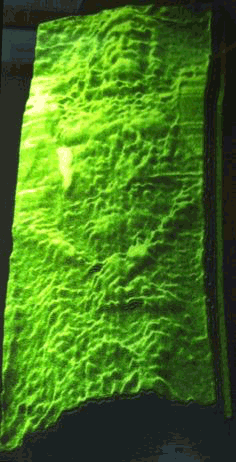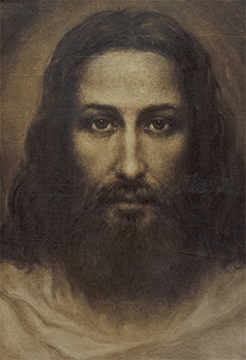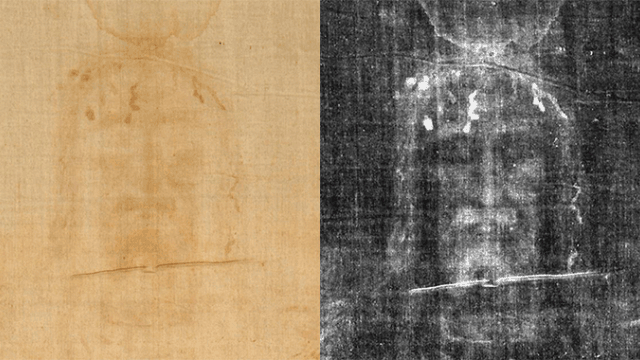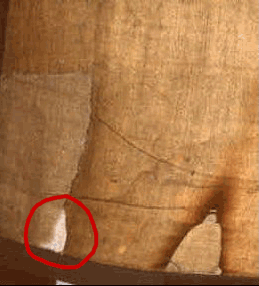It’s no secret that Gary The Gospel Guy is a believer in Jesus. I believe that Jesus really is God Almighty inhabiting a human body — the God-Man. I believe that God has shown Himself in three Persons: Father; Son; and Holy Spirit (I may do an in-depth article on the Trinity one day). I believe that He actually walked the earth in the first century, AD. He lived. He died. He came back to life in three days (killed on a Friday, raised on a Sunday morning). Now He is in the Spirit Realm until He returns to earth.
If the Bible stories of Jesus are true, then we should expect to find some kind of extrabiblical evidence of His life (evidence from somewhere other than the Bible).
Description
The Shroud of Turin, if you’ve never heard of it, is a piece of linen cloth (not cotton) about 14 feet long by about 3½ feet wide. It was woven using a herringbone weave, which was typical in first-century fine Egyptian linen. It has been studied very carefully in recent decades and there are microscopic deposits on the shroud of pollens, dirt, oils and other human residues. But the really interesting things that are on the cloth are human blood and an image of a naked young man, full length, both front and back. Also on the cloth is evidence of fire damage and subsequent repair. It has been housed in the Cathedral of St. John the Baptist (not the apostle), in Turin, northern Italy since 1578.
Everyone agrees that it is a kind of burial cloth, or at least, representative of such. The big debate is over the actual age of the cloth, which leads to the bigger question of whose image is on it, which may or may not answer the question of the reality of God. And of course, whether we should be submitting ourselves to His rule or not.
If the cloth was created in the 14th century, as some claim, then it is just another piece of art — a mystery of what it is supposed to be. And if it is a fake, a forgery, then I wonder what it was supposed to be a copy of? I mean, if we make a forgery of a famous painting, there must be an original to copy. But nothing else exists in the world that is like this cloth. But I’ve gotten ahead of myself.

History
This cloth first hit the limelight in France, during the 1300’s. If I remember my reading on this, there was a widow of a French knight who took part in a crusade to Istanbul. She tried to sell the thing to support herself but a bishop said that it was a fake. I don’t recall if she ever got anything for it, but it soon became property of the church. While in the church in Lirey, France, the cloth was kept in a silver-plated chest. The church caught on fire and the chest was barely saved from complete destruction. Unfortunately, the silver melted and dripped into the chest, onto the cloth, burning it and leaving a burn pattern on the folded shroud. After that the House of Savoy came into possession of the shroud and it now rests in Turin, Italy. Luckily, the image of the man was mostly missed by the burns.
The Image
Here’s the really fascinating thing about this cloth. Like I’ve said, it was a burial cloth. (That’s not the interesting part, many cloths have been used to wrap dead bodies for millennia.) What is interesting about it is that it has the image of a man on it. We’re not talking about a smudge here. This image is a head to toe, front and back image of a naked young man. And as interesting as that is — unique to this one — no one can say with certainty how the image was made.
In 1978, a team of scientists, called the Shroud of Turin Research Project (STURP) spent a total of 120 hours examining the cloth. These scientists weren’t slouches; they were highly educated and experienced in their fields of study. And when they examined the shroud, they really took a close look. What they determined, through careful examination, was that the image was barely on the surface of the linen. It didn’t go completely through from one side of the fibers to the other. In fact, it barely rests on the cloth at all. It is the result of caramelization of the topmost fibrils on the cloth. Again, not even halfway through the fibers. This is precision burning. Even our modern lasers can’t do this. They also were able to definitively rule out any type of art application to the cloth. There were no paints, dyes, oils, pigments, or any other kind of medium or instrument used for the application of something to leave an image. This means that no artist of the 14th century (or any other time) could have known how to make such an image.
But the really amazing aspects of this image are:
- It produces a perfect 3-D image when scanned by a NASA instrument
- It is made in the NEGATIVE.
3-D Image

In 1976, American Physicist John Jackson with colleagues Eric Jumper and Bill Mottern, who were researchers with the famous Los Alamos National Laboratory in NM, scanned a Shroud photograph on a VP-8 digital image analyzer. This instrument is used to look at planets and other objects in space to determine their topography. Amazingly, the image showed perfect 3-D characteristics of the image. Whenever a drawing is scanned by this machine, it has a hard time seeing the image the way that the human brain does. What we would see as a raised part of the image, like the nose, might be interpreted as a concave part by the analyzer. This is very significant in looking at the shroud. Every part that is supposed to be convex is convex. Every part that is to be concave is concave. The odds of this happening to an artists drawing are astronomical (no pun intended — ok, maybe it is).
Remember that this cloth emerged into the spotlight in the 14th century, when art wasn’t exactly realistic (not like the realism of today). Also, up until then, the common expectation was that Jesus’ hands were pierced, not His wrists (as shown on the shroud).
It’s a Negative Image
But the most amazing thing to me is that the image is done in a way that no one of the 14th century could have even conceived of. It is as if the cloth were film in a camera. In photography (not digital), when the photographer goes into her lab to “develop” a photo, she first makes a “negative”. If you’ve ever seen a negative it isn’t much to look at. The darks are light and the lights are dark. It’s a reverse of the light and dark tones. It doesn’t really make sense to the mind until it’s developed. There’s a huge difference between developed and undeveloped photographs.
On May 28, 1898, Secondo Pia, an Italian lawyer and amateur photographer, took the first photographs of the Shroud of Turin. Imagine his amazement when he looked at his negative in the darkroom, which showed all of the detail of a developed photo! He instantly realized that he was looking at a negative of a negative, which equals a positive (like in math). Suddenly, all of the detail of the image just popped out. Such a technique was not only unknown but completely unattainable to any artist then or before then. And remember, no person can replicate the image with all of the detail and the same characteristics (think VP-8 imagery) as the shroud.
Carbon Dating
The STURP team, that studied the cloth twice, was not allowed to perform any destructive analysis of the cloth. This means that they weren’t allowed to perform any carbon dating on it. Unfortunately, they could have done it using the charred residue from the burned areas, but I guess they either didn’t think of this or weren’t even allowed to do that. Anyway, in 1988 Carbon 14 dating was allowed to be performed on the shroud.
The Carbon-14 specimen was taken from a part of the cloth that was repaired by nuns in the 14th century, after the fire. They stained the new cloth and sewed it in very carefully. They did such a good job that no one could tell with the naked eye where the repair was made.
Unfortunately for us all, when the cloth was cut to remove the piece to be analyzed they took some of the new cloth. Obviously, this threw off the date for the cloth by a huge amount. In the image here (taken in 1978), we can see the difference because the photo was taken using a kind of UV fluorescence filter, which shows the different characteristics of the different cloths (the new and the old). And of course, those who don’t want the shroud to be authentic jumped on this and made it seem like the shroud was a fake. But again I ask, a fake of what? Who would have thought of making a knock-off of something that never existed? There are no other burial cloths that have such an image on them. A negative image was unknown at the time that this “fake” was supposedly manufactured. No one realized that Jesus was pierced through the wrists, not the hands. No pigments, dyes, or other artistic elements exist on the cloth. It is perfectly shaded — enough for the VP-8 analyzer to render a perfect 3-D image. It does not fit into the art techniques and methods of the time. But wait, there’s more…
Blood
The wounds on the shroud are depicted so perfectly that it would be virtually impossible for someone to replicate them to the level of detail that they are. Forensic scientists have determined that the blood on the cloth is human. They can also tell that there are many injuries depicted on the man’s image that show a person who suffered several wounds before his death and after.
There are multiple “punctate” wounds about the scalp. These wounds are apparently caused by something sharp, like the large thorns that are indigenous to the region of Israel. Rather than imagining a ring around the victim’s head, imagine a cap placed on his head. And then imagine a bunch of men taking turns hitting the cap with a staff, driving the thorns into the skin of the scalp.

The nose has been broken, a knee scraped, as if from a fall, the cheeks have been bruised, one eye is swollen shut, hair has been torn out from the beard, but the really deadly wounds are the stripes from a scourge. It can be determined that two men, one taller than the other, stood on each side of the victim (who was apparently bound to a pole with his arms raised) while they each whipped him with a flagrum type device. A flagrum was a Roman whip with three straps that included bits of bone and metal for ripping the flesh as they were being withdrawn from a blow across the skin. This would painfully rip the skin from the flesh and cause horrible wounds. Now imagine having those open wounds pressed against a splintery board, which you had to rub up against to draw breath. The scourge wounds covered the torso, the buttocks, and the legs, front and back.
The wounds on the wrists and feet are what would be expected if a body were to be nailed to a cross and suspended indefinitely. This is because the wrist bones, when a spike is driven through them, will separate enough to allow the spike to go through, while providing enough continuity to hold the weight of the victim in an upright position. It’s like using a washer to hold a nail in place in soft material. When this is done to the wrist, the thumb is forced over to cover the palm. Amazingly, the shroud shows how the thumbs would have been as a result of such a condition. The left foot was placed over the right and a single spike went through both feet. It went through the top of the left foot and came out the heel of the right.
From the puncture wounds on the wrists, blood trickled down the forearm to the elbow where it would have dripped onto the ground.
On the right side of the victim, a stab wound is present where the presence of a post-mortem fluid is detectable along with the blood. After such a death, the heart sack would have contained this fluid and when the heart was pierced (to ensure death) it would have run with the blood out of the wound. That is a detail that no one in previous centuries would have contemplated, but there it is. The blood from the side wound (post-mortem) continued to trickle when the body was taken down and placed on the shroud. As the corpse lay motionless, the blood still ran along the curvature of the torso and pooled in the small of the back. All of the blood showed signs of coagulation, meaning it was not simply brushed on from some supply of human blood.
Another telltale sign of the means of death (not related to blood) is how the abdomen shows that it was bulged. A distended abdomen is associated with death by suffocation. Suffocation is usually the means of death in crucifixion. This is how Jesus could have labored the words “It is finished” upon His death. He simply quit raising up for air. You can see what this is like by holding your arms up to the side, above your head slightly and tilting your head down at the same time. It cuts off the airflow. The VP-8 image even shows this little detail.
Conclusion
There are simply too many details about this amazing artifact that are completely in line with the crucifixion account of Jesus, the Man from Nazareth. Not one person on the planet can replicate all of the details that are present on this cloth. No one. You can use whatever methods and equipment you wish, but you aren’t going to come close. Lasers can’t burn that precisely (and burning is the only method that would replicate it). No one knew about negative images before the turn of the 20th century. Every tiny detail perfectly matches what happened to Jesus — even those details that no one knew about in subsequent centuries (previous to now). And the gradients in your fake image must be absolutely perfect for the VP-8 to interpret them correctly.
Now you have a choice. You can latch on to those people (whether they call themselves “experts” or not) who continually poo-poo the shroud, no matter the weight of the evidence; or you can open your eyes, heart, and mind to the obvious conclusion that this cloth was indeed the burial cloth of Jesus of Nazareth in the first century AD. For me, this is definitely extrabiblical proof — forensic proof — of the life, death, burial, and resurrection of Yeshua.
My conclusion is that the image was produced when the Lord reanimated His Body with His Spirit upon His resurrection. His glory (power, light, magnificence) was so great at that very moment, it imprinted a negative image on the cloth covering His body just as a camera film receives the shutter image upon exposure. What a gift! He gave us a picture of Himself at the very moment of His “resurrection”.

Do what you wish with this information. I have personally spent many, many hours studying this thing. I’ve heard arguments from both sides and have made up my mind about it. It isn’t something that is to be revered or worshipped; it is a photo of our Loved One, Whom we do adore. At least, I do. And I hope that you will too.
In Him,
Gary
Sign up for my email updates. When I post new content, you’ll get it in your inbox.



